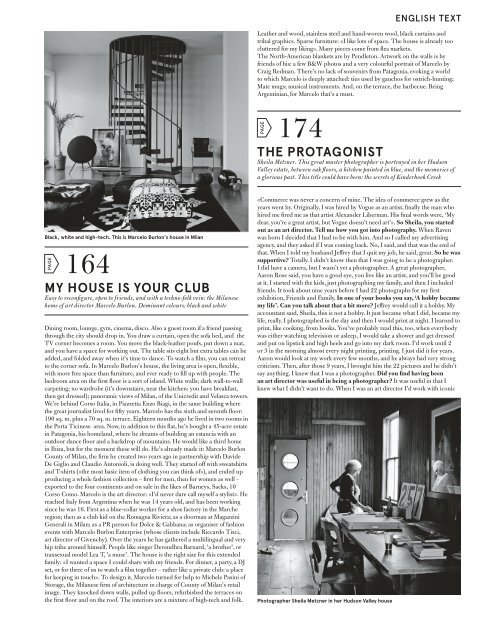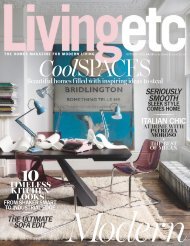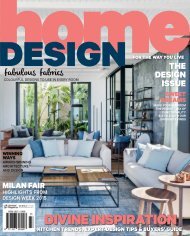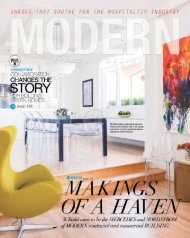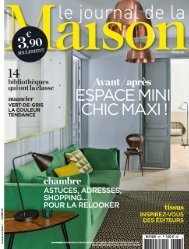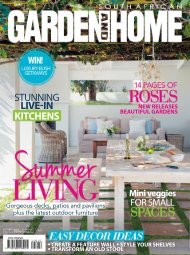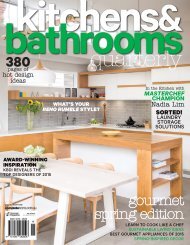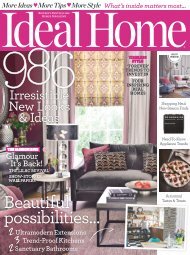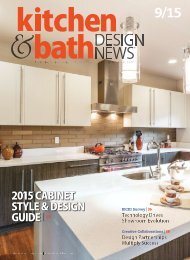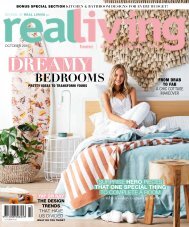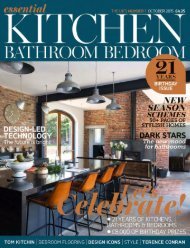LivingSettembre2015
- No tags were found...
You also want an ePaper? Increase the reach of your titles
YUMPU automatically turns print PDFs into web optimized ePapers that Google loves.
ENGLISH TEXT<br />
Leather and wood, stainless steel and hand-woven wool, black curtains and<br />
tribal graphics. Sparse furniture: «I like lots of space. The house is already too<br />
cluttered for my liking». Many pieces come from fea markets.<br />
The North-American blankets are by Pendleton. Artwork on the walls is by<br />
friends of his: a few B&W photos and a very colourful portrait of Marcelo by<br />
Craig Redman. There’s no lack of souvenirs from Patagonia, evoking a world<br />
to which Marcelo is deeply attached: ties used by gauchos for ostrich-hunting;<br />
Mate mugs; musical instruments. And, on the terrace, the barbecue. Being<br />
Argentinian, for Marcelo that’s a must.<br />
PAGE<br />
174<br />
the PROtAGONISt<br />
Sheila Metzner. This great master photographer is portrayed in her Hudson<br />
Valley estate, between oak foors, a kitchen painted in blue, and the memories of<br />
a glorious past. This title could have been: the secrets of Kinderhook Creek<br />
Black, white and high-tech. this is Marcelo Burlon's house in Milan<br />
PAGE<br />
164<br />
MY hOUSe IS YOUR CLUB<br />
Easy to reconfgure, open to friends, and with a techno-folk vein: the Milanese<br />
home of art director Marcelo Burlon. Dominant colours: black and white<br />
Dining room, lounge, gym, cinema, disco. Also a guest room if a friend passing<br />
through the city should drop in. You draw a curtain, open the sofa bed, and the<br />
TV corner becomes a room. You move the black-leather poufs, put down a mat,<br />
and you have a space for working out. The table sits eight but extra tables can be<br />
added, and folded away when it’s time to dance. To watch a flm, you can retreat<br />
to the corner sofa. In Marcelo Burlon’s house, the living area is open, fexible,<br />
with more free space than furniture, and ever ready to fll up with people. The<br />
bedroom area on the frst foor is a sort of island. White walls; dark wall-to-wall<br />
carpeting; no wardrobe (it’s downstairs, near the kitchen: you have breakfast,<br />
then get dressed); panoramic views of Milan, of the Unicredit and Velasca towers.<br />
We’re behind Corso Italia, in Piazzetta Enzo Biagi, in the same building where<br />
the great journalist lived for ffty years. Marcelo has the sixth and seventh foor:<br />
190 sq. m. plus a 70 sq. m. terrace. Eighteen months ago he lived in two rooms in<br />
the Porta Ticinese area. Now, in addition to this fat, he’s bought a 45-acre estate<br />
in Patagonia, his homeland, where he dreams of building an estancia with an<br />
outdoor dance foor and a backdrop of mountains. He would like a third home<br />
in Ibiza, but for the moment these will do. He’s already made it: Marcelo Burlon<br />
County of Milan, the frm he created two years ago in partnership with Davide<br />
De Giglio and Claudio Antonioli, is doing well. They started of with sweatshirts<br />
and T-shirts («the most basic item of clothing you can think of»), and ended up<br />
producing a whole fashion collection – frst for men, then for women as well –<br />
exported to the four continents and on sale in the likes of Barneys, Sacks, 10<br />
Corso Como. Marcelo is the art director: «I’d never dare call myself a stylist». He<br />
reached Italy from Argentina when he was 14 years old, and has been working<br />
since he was 16. First as a blue-collar worker for a shoe factory in the Marche<br />
region; then as a club kid on the Romagna Riviera; as a doorman at Magazzini<br />
Generali in Milan; as a PR person for Dolce & Gabbana; as organiser of fashion<br />
events with Marcelo Burlon Enterprise (whose clients include Riccardo Tisci,<br />
art director of Givenchy). Over the years he has gathered a multilingual and very<br />
hip tribe around himself. People like singer Devendhra Barnard, ‘a brother’, or<br />
transexual model Lea T, ‘a muse’. The house is the right size for this extended<br />
family: «I wanted a space I could share with my friends. For dinner, a party, a DJ<br />
set, or for three of us to watch a flm together – rather like a private club: a place<br />
for keeping in touch». To design it, Marcelo turned for help to Michele Pasini of<br />
Storage, the Milanese frm of architecture in charge of County of Milan’s retail<br />
image. They knocked down walls, pulled up foors, refurbished the terraces on<br />
the frst foor and on the roof. The interiors are a mixture of high-tech and folk.<br />
«Commerce was never a concern of mine. The idea of commerce grew as the<br />
years went by. Originally, I was hired by Vogue as an artist, fnally the man who<br />
hired me fred me as that artist Alexander Liberman. His fnal words were, ‘My<br />
dear, you’re a great artist, but Vogue doesn’t need art’». So Sheila, you started<br />
out as an art director. Tell me how you got into photography. When Raven<br />
was born I decided that I had to be with him. And so I called my advertising<br />
agency, and they asked if I was coming back. No, I said, and that was the end of<br />
that. When I told my husband Jefrey that I quit my job, he said, great. So he was<br />
supportive? Totally. I didn’t know then that I was going to be a photographer.<br />
I did have a camera, but I wasn’t yet a photographer. A great photographer,<br />
Aaron Rose said, you have a good eye, you live like an artist, and you’ll be good<br />
at it. I started with the kids, just photographing my family, and then I included<br />
friends. It took about nine years before I had 22 photographs for my frst<br />
exhibition, Friends and Family. In one of your books you say, ‘A hobby became<br />
my life’. Can you talk about that a bit more? Jefrey would call it a hobby. My<br />
accountant said, Sheila, this is not a hobby. It just became what I did, became my<br />
life, really. I photographed in the day and then I would print at night. I learned to<br />
print, like cooking, from books. You’ve probably read this, too, when everybody<br />
was either watching television or asleep, I would take a shower and get dressed<br />
and put on lipstick and high heels and go into my dark room. I’d work until 2<br />
or 3 in the morning almost every night printing, printing. I just did it for years.<br />
Aaron would look at my work every few months, and he always had very strong<br />
criticism. Then, after those 9 years, I brought him the 22 pictures and he didn’t<br />
say anything. I knew that I was a photographer. Did you fnd having been<br />
an art director was useful in being a photographer? It was useful in that I<br />
knew what I didn’t want to do. When I was an art director I’d work with iconic<br />
Photographer Sheila Metzner in her hudson Valley house


